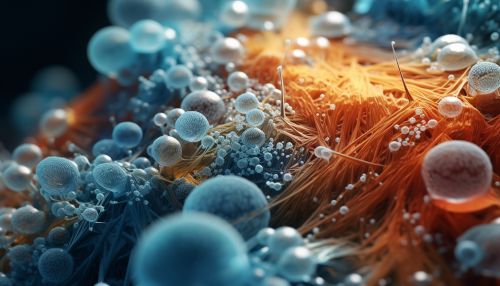Mechanisms of Microbial Degradation of Pollutants in Biofilms
Introduction
Microbial degradation of pollutants is a crucial process in environmental biotechnology. It involves the breakdown of pollutants by microorganisms into less harmful substances. This process is particularly significant in biofilms, which are complex microbial communities that form on surfaces in aqueous environments. Biofilms are characterized by a self-produced matrix of extracellular polymeric substances (EPS) that provide a protective environment for the microbial cells.


Biofilms and Pollutant Degradation
Biofilms play a significant role in the degradation of pollutants due to their unique structure and properties. The EPS matrix in biofilms not only protects the microbial cells from harmful substances but also facilitates the diffusion of nutrients and pollutants, thereby enhancing the degradation process. The microbial cells in biofilms exhibit a high level of physiological diversity, which allows them to degrade a wide range of pollutants.
Mechanisms of Microbial Degradation in Biofilms
Microbial degradation of pollutants in biofilms involves several mechanisms, including co-metabolism, cometabolism, and mineralization. In co-metabolism, the pollutant is degraded as a secondary substrate alongside the primary substrate. In cometabolism, the pollutant is degraded in the presence of a primary substrate but without gaining any energy or nutrients from the process. In mineralization, the pollutant is completely degraded to inorganic compounds.
Co-metabolism
Co-metabolism is a common mechanism of microbial degradation in biofilms. It involves the degradation of a pollutant as a secondary substrate alongside the primary substrate. The pollutant is not used as a source of energy or nutrients, but its degradation is facilitated by the metabolic activity of the microorganisms on the primary substrate. This mechanism is particularly effective in the degradation of recalcitrant pollutants that cannot be degraded by other mechanisms.
Cometabolism
Cometabolism is another important mechanism of microbial degradation in biofilms. It involves the degradation of a pollutant in the presence of a primary substrate but without gaining any energy or nutrients from the process. The pollutant is degraded as a result of the enzymatic activity of the microorganisms on the primary substrate. This mechanism is often involved in the degradation of complex organic pollutants that require specific enzymes for their breakdown.
Mineralization
Mineralization is the ultimate goal of microbial degradation in biofilms. It involves the complete degradation of a pollutant to inorganic compounds such as carbon dioxide, water, and mineral salts. This process is facilitated by the metabolic activity of the microorganisms and the unique properties of the biofilm matrix. Mineralization ensures the complete removal of the pollutant from the environment, thereby reducing its harmful effects.
Factors Influencing Microbial Degradation in Biofilms
Several factors influence the efficiency of microbial degradation in biofilms. These include the nature of the pollutant, the characteristics of the biofilm, and the environmental conditions. The nature of the pollutant determines its accessibility and degradability by the microorganisms. The characteristics of the biofilm, such as its structure and composition, influence the diffusion of the pollutant and the activity of the microorganisms. The environmental conditions, such as temperature and pH, affect the metabolic activity of the microorganisms and the stability of the biofilm.
Applications of Microbial Degradation in Biofilms
Microbial degradation in biofilms has several applications in environmental biotechnology. It is used in the treatment of wastewater, the remediation of contaminated soil, and the detoxification of industrial effluents. Biofilms are also used in bioreactors for the degradation of specific pollutants. The efficiency of these applications depends on the understanding and manipulation of the mechanisms of microbial degradation in biofilms.
Conclusion
Microbial degradation of pollutants in biofilms is a complex process that involves several mechanisms and is influenced by various factors. Understanding these mechanisms and factors is crucial for the effective application of this process in environmental biotechnology. Further research is needed to enhance the efficiency of microbial degradation in biofilms and to explore its potential applications in the treatment of various types of pollutants.
